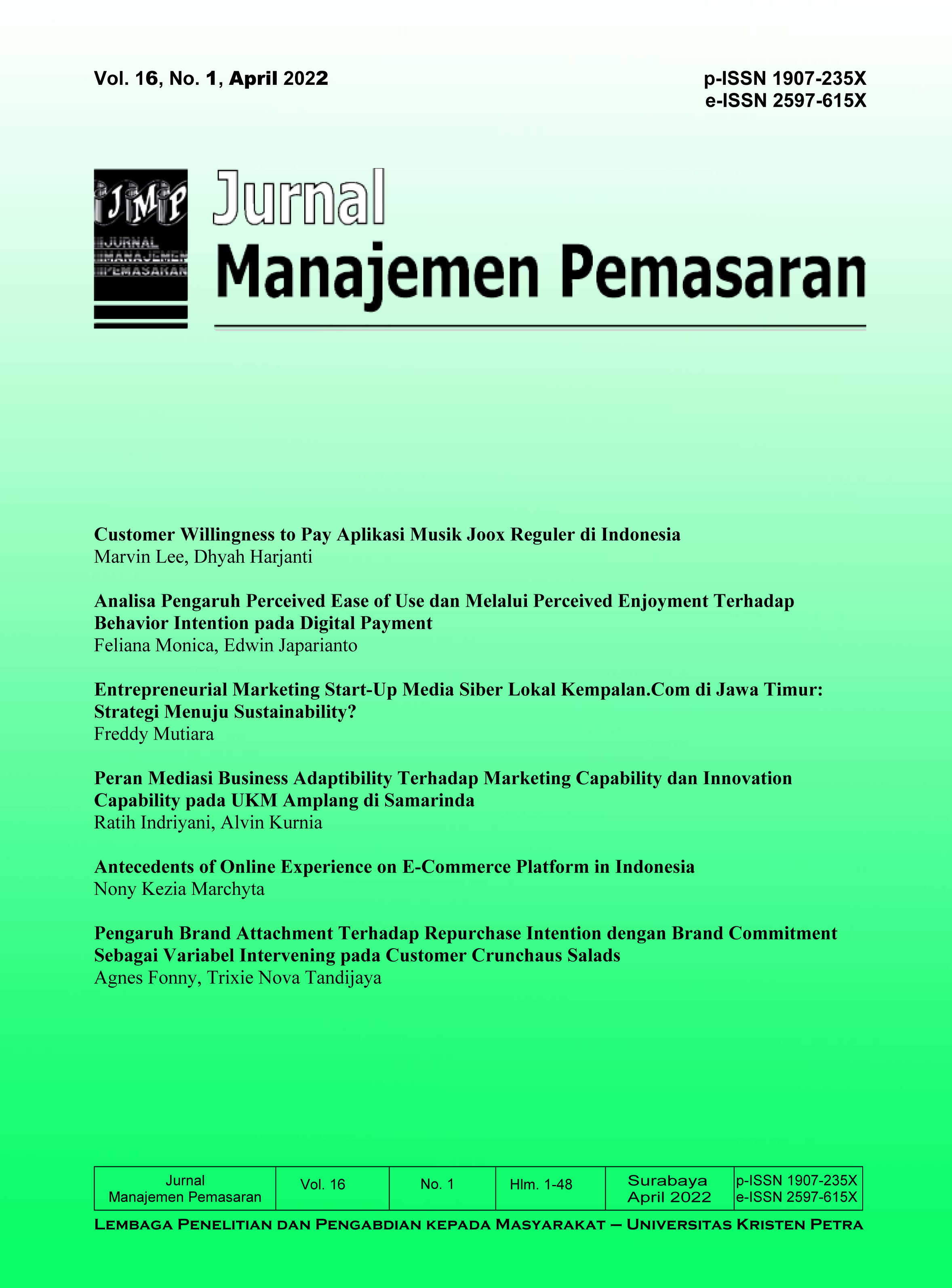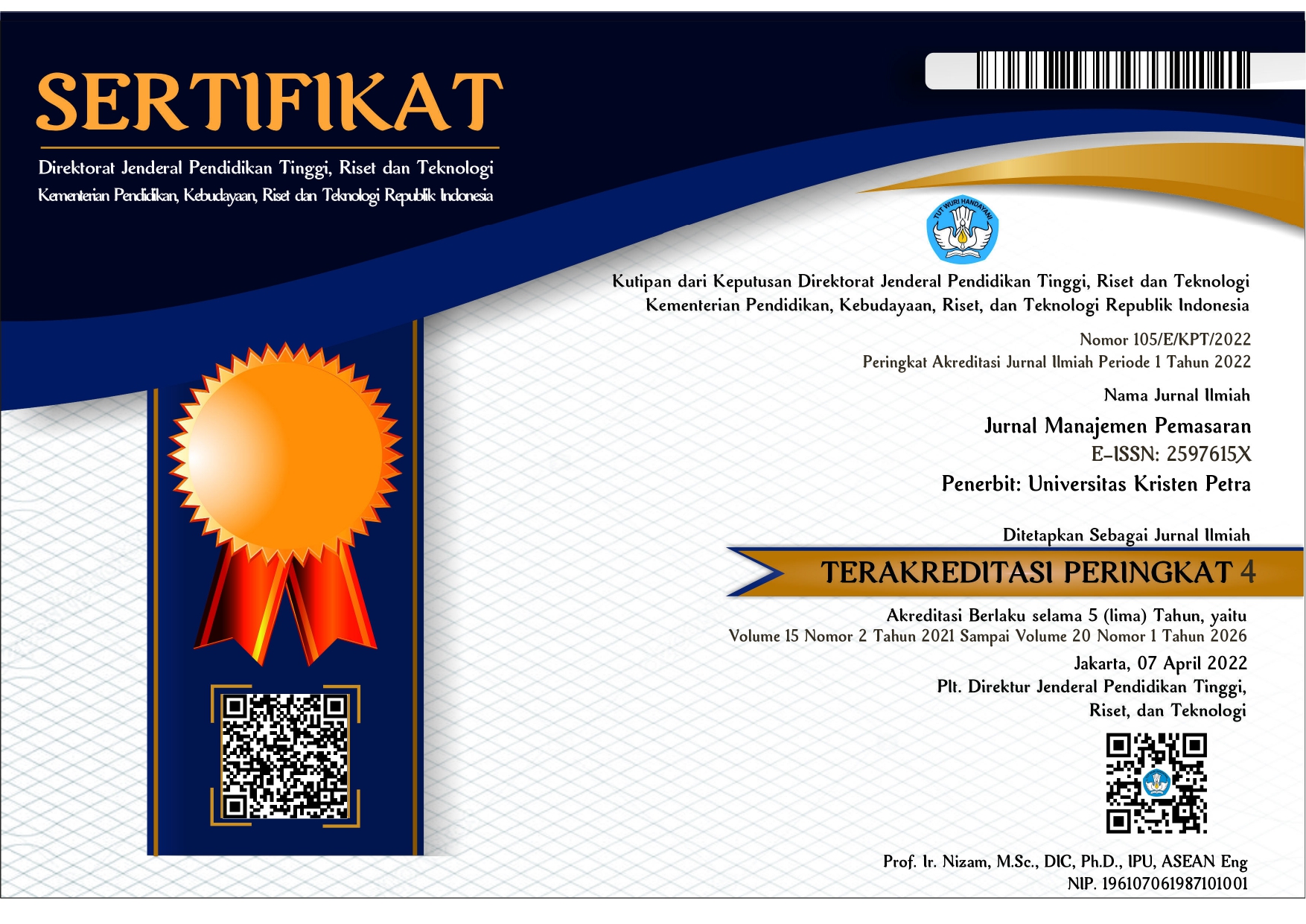PENGARUH BRAND ATTACHMENT TERHADAP REPURCHASE INTENTION DENGAN BRAND COMMITMENT SEBAGAI VARIABEL INTERVENING PADA CUSTOMER CRUNCHAUS SALADS
DOI:
https://doi.org/10.9744/pemasaran.16.1.37-48Keywords:
Brand attachment, repurchase intention, brand commitmentAbstract
Nowadays, business competition have been increasingly fierce. Brands must be able to establish close relationships with consumers to win the market. One of the customer-brand relationships that can bind both sides to touch the psychological side of consumers is brand attachment. This study aims to analyze the effect of brand attachment on repurchase intention with brand commitment as an intervening variable on Crunchaus Salads customers. The results of this study prove that the consumer's attachment and commitment to the brand can affect the repurchase behavior of the brand.
Abstrak:
Semakin ketatnya persaingan bisnis saat ini, menjadikan brand harus mampu menjalin hubungan relasi yang dekat dan erat dengan konsumen agar brand dapat memenangkan pasar. Salah satu hubungan relasi antara customer-brand yang mampu mengikat kedua pihak hingga menyentuh sisi psikologis konsumen adalah brand attachment. Penelitian ini bertujuan untuk menganalisa pengaruh brand attachment terhadap repurchase intention dengan brand commitment sebagai variabel intervening pada customer Crunchaus Salads. Hasil penelitian ini membuktikan bahwa keterikatan dan komitmen konsumen terhadap brand dapat mempengaruhi perilaku pembelian ulang pada brand tersebut.
References
Arya, V., Sethi, D., & Verma, H. (2018). Are emojis fascinating brand value more than textual language? Mediating role of brand communi-cation to SNS and brand attachment: An insight from India. Corporate Communications, 23(4), 648–670. https://doi.org/10.1108/CCIJ-03-2018-0036
Aureliano-Silva, L., Strehlau, S., & Strehlau, V. (2017). The Relationship between Brand Attachment and Consumers’ Emotional Well-Being. Journal of Relationship Marketing, 0(0), 1–16. https://doi.org/10.1080/15332667.2017.1391058
Bahri-Ammari, N., Van Niekerk, M., Ben Khelil, H., & Chtioui, J. (2016). The effects of brand attach-ment on behavioral loyalty in the luxury restaurant sector. International Journal of Contem-porary Hospitality Management, 28(3), 559–585. https://doi.org/10.1108/IJCHM-10-2014-0508
Belaid, S., & Behi, A. T. (2011). The role of attachment in building consumer-brand relationships: An empirical investigation in the utilitarian consumption context. Journal of Product and Brand Management, 20(1), 37–47. https://doi.org/10.1108/10610421111108003
Bowlby, J. (1977). The making and breaking of affectional bonds. I. Aetiology and psychopathology in the light of attachment theory. An expanded version of the Fiftieth Maudsley Lecture, delivered before the Royal College of Psychiatrists, 19 November 1976. British Journal of Psychiatry, 130(3), 201–210. https://doi.org/10.1192/bjp.130.3.201
Burmann, C., & Zeplin, S. (2005). Building brand commitment: A behavioural approach to internal brand management. 12(4), 279–300.
Chan, E. Y., & Ilicic, J. (2019). Political ideology and brand attachment. International Journal of Research in Marketing, 36(4), 630–646. https://doi.org/10.1016/j.ijresmar.2019.04.001
Chernev, A., Hamilton, R., & Gal, D. (2011). Competing for consumer identity: Limits to self-expression and the perils of lifestyle branding. Journal of Marketing, 75(3), 66–82. https://doi.org/10.1509/jmkg.75.3.66
Chiu, W., & Won, D. (2016). Consumer-brand relationships in sports products and repurchase intention: An application of the investment model. International Journal of Sports Marketing and Sponsorship, 17(3), 243–259. https://doi.org/10.1108/IJSMS-08-2016-013
Dennis, C., Papagiannidis, S., Alamanos, E., & Bourlakis, M. (2016). The role of brand attachment strength in higher education. Journal of Business Research, 69(8), 3049–3057. https://doi.org/10.1016/j.jbusres.2016.01.020
Esch, F. R., Langner, T. L., Schmitt, B. H., & Geus, P. (2006). Are brands forever? How brand know-ledge and relationships affect current and future purchases. Journal of Product and Brand Mana-gement, 15(2), 98–105. https://doi.org/10.1108/10610420610658938
Fedorikhin, A., Park, C. W., & Thomson, M. (2008). Beyond fit and attitude: The effect of emotional attachment on consumer responses to brand extensions. Journal of Consumer Psychology, 18(4), 281–291. https://doi.org/10.1016/j.jcps.2008.09.006
Hew, J. J., Badaruddin, M. N. B. A., & Moorthy, M. K. (2016). Crafting a smartphone repurchase decision making process: Do brand attachment and gender matter? Telematics and Informatics, 34(4), 34–56. https://doi.org/10.1016/j.tele.2016.12.009
Hwang, E., Baloglu, S., & Tanford, S. (2019). Building loyalty through reward programs: The influence of perceptions of fairness and brand attachment. International Journal of Hospitality Manage-ment, 76, 19–28. https://doi.org/10.1016/j.ijhm.2018.03.009
Japutra, A., Ekinci, Y., & Simkin, L. (2014). Exploring brand attachment, its determinants and outcomes. Journal of Strategic Marketing, 22(7), 616–630. https://doi.org/10.1080/0965254X.2014.914062
Japutra, A., Ekinci, Y., & Simkin, L. (2018). Tie the knot: building stronger consumers’ attachment toward a brand. Journal of Strategic Marketing, 26(3), 223–240. https://doi.org/10.1080/09652 54X.2016.1195862
Kang, J., Manthiou, A., Sumarjan, N., & Tang, L. (Rebecca). (2017). An Investigation of Brand Experience on Brand Attachment, Knowledge, and Trust in the Lodging Industry. Journal of Hospitality Marketing and Management, 26(1), 1–22. https://doi.org/10.1080/19368623.2016.1172534
Khan, M. A., Panditharathna, R., & Bamber, D. (2020). Online store brand experience impacting on online brand trust and online repurchase intention: The moderating role of online brand attachment. European Journal of Management and Marketing Studies, 5(1), 128–162. https://doi.org/10.5281/zenodo.3668792
Kotler, P., & Keller, kevin lane. (2012). Marketing Management. In S. Yagan (Ed.), Essentials of Management for Healthcare Professionals (14th ed.). Pearson Education. https://doi.org/10.4324/9781315099200-17
Lee, J. H., Kim, H. D., Ko, Y. J., & Sagas, M. (2011). The influence of service quality on satisfaction and intention: A gender segmentation strategy. Sport Management Review, 14(1), 54–63. https://doi.org/10.1016/j.smr.2010.02.002
Li, M. W., Teng, H. Y., & Chen, C. Y. (2020). Unlocking the customer engagement-brand loyalty relationship in tourism social media: The roles of brand attachment and customer trust. Journal of Hospitality and Tourism Management, 44(June), 184–192. https://doi.org/10.1016/j.jhtm.2020.06.015
Lim, X. J., Cheah, J. H., Cham, T. H., Ting, H., & Memon, M. A. (2020). Compulsive buying of branded apparel, its antecedents, and the mediating role of brand attachment. Asia Pacific Journal of Marketing and Logistics, 32(7), 1539–1563. https://doi.org/10.1108/APJML-03-2019-0126
Louis, D., & Lombart, C. (2010). Impact of brand personality on three major relational consequences (trust, attachment, and commitment to the brand). Journal of Product and Brand Management, 19(2), 114–130. https://doi.org/10.1108/10610421011033467
Malär, L., Krohmer, H., Hoyer, W. D., & Nyffenegger, B. (2011). Emotional brand attachment and brand personality: The relative importance of the actual and the ideal self. Journal of Marketing, 75(4), 35–52. https://doi.org/10.1509/jmkg.75.4.35
Maurya, U. K., & Mishra, P. (2012). What is a brand? A Perspective on Brand Meaning. European Journal of Business and Management, 4(3), 122–134. http://www.iiste.org/Journals/index.php/EJBM/article/view/1322
Monique Tello, MD, M. (2020). Healthy lifestyle: 5 keys to a longer life. In harvard health publishing (Vol. 2). https://www.health.harvard.edu/blog/ healthy-lifestyle-5-keys-to-a-longer-life-201807 0514186
Morgan, R. M., & Hunt, S. D. (1994). The Commitment-Trust Theory of. Journal of Marketing, 58(July), 20–38. https://journals.sagepub.com/doi/full/10.1177/002224299405800302
N. Allen, & J. Meyer. (1990). The measurement and antecedents of affective, continuance and norma-tive commitment to the organization. Journal of Occupational Psychology., 1–18.
Park, C., MacInnis, D., & Priester, J. (2006). Beyond Attitudes: Attachment and Consumer Behavior. Seoul National Journal, 12(2), 3–36.
Park, C. W., MacInnis, D. J., & Priester, J. (2006). Brand attachment: Constructs, consequences, and causes. In Foundations and Trends in Marketing (Vol. 1, Issue 4). https://doi.org/10.1561/1700000006
Peng, N., & Chen, A. (2019). Examining consumers’ luxury hotel stay repurchase intentions-incor-porating a luxury hotel brand attachment variable into a luxury consumption value model. International Journal of Contemporary Hospitality Management, 31(3), 1348–1366. https://doi.org/10.1108/IJCHM-04-2018-0332
Priherdityo, E. (2016, September). Survei: Masyarakat Indonesia Mulai Sadar Makanan Sehat. CNN Indonesia. https://www.cnnindonesia.com/gayahidup/20160909050532-255-157172/survei-masyarakat-indonesia-mulai-sadar-makanan-sehat
Ramaseshan, B., & Stein, A. (2014). Connecting the dots between brand experience and brand loyalty: The mediating role of brand personality and brand relationships. Journal of Brand Mana-gement, 21(7/), 664–683. https://doi.org/10.1057/ bm.2014.23
Riyanto, S., P Asturiningtyas, I., Setianingsih, I., Nur’aini, N., Zainuddin, Z., Purwoko, S., Prihatin, A., & Mirzautika, A. (2021). Healthy lifestyles during the COVID-19 new normal era in Indonesia. Annals of Tropical Medicine & Public Health, 24(01). https://doi.org/10.36295/asro.2021.24174
Setiawan, D. (2020). Pengaruh Brand Personality, Trust In The Brand, Attachment To The Brand Terhadap Commitment To The Brand. Jurnal Manajemen Bisnis Dan Kewirausahaan, 4(4), 94. https://doi.org/10.24912/jmbk.v4i4.8660
Shuv-Ami, A. (2012). Brand commitment: A new four-dimensional (4 Es) conceptualisation and scale. Journal of Customer Behavior, 11(3), 281–305.
Simangunsonga, E. C. C., & Hariandjab, E. S. (2020). Brand jealousy and willingness to pay premium: The mediating role of materialism. Asia Pacific Ournal of Advanced Business and Social Studies (APIAR), 6(1), 86–95. https://doi.org/10.1057/s41262-016-0016-2
Simanjuntak, M., Nur, H. R., Sartono, B., & Sabri, M. F. (2020). A general structural equation model of the emotions and repurchase intention in modern retail. Management Science Letters, 10(4), 801–814. https://doi.org/10.5267/j.msl.2019.10.017
Sugiyono. (2007). Statistika untuk penelitian (A. Nuryanto (ed.)). Alfabeta.
Sugiyono. (2011). Pengertian Populasi Dan Sampel Dalam Penelitian. Blog’s Bimbingan. https://sugithewae.wordpress.com/2012/11/13/pengertian-populasi-dan-sampel-dalam-penelitian/
Thomson, M., MacInnis, D. J., & Park, C. W. (2005). The ties that bind: Measuring the strength of consumers’ emotional attachments to brands. Journal of Consumer Psychology, 15(1), 77–91. https://doi.org/10.1207/s15327663jcp1501_10
Wang, E. S.-T., & Tsai, M.-C. (2019). Effects of the perception of traceable fresh food safety and nutrition on perceived health benefits, affective commitment, and repurchase intention. Food Quality and Preference, 78(June), 103723. https://doi.org/10.1016/j.foodqual.2019.103723
Whan Park, C., Maclnnis, D. J., Priester, J., Eisingerich, A. B., & Lacobucci, D. (2010). Brand attachment and brand attitude strength: Conceptual and empirical differentiation of two critical brand equity drivers. Journal of Marketing, 74(6), 1–17. https://doi.org/10.1509/jmkg.74.6.1
Wu, J., Chen, J., & Dou, W. (2016). The Internet of Things and interaction style: the effect of smart interaction on brand attachment. Journal of Marketing Management, 33(1–2), 61–75. https://doi.org/10.1080/0267257X.2016.1233132
Yang, S., Lu, Y., Chau, P. Y. K., & Gupta, S. (2017). Role of channel integration on the service quality, satisfaction, and repurchase intention in a multi-channel (online-cum-mobile) retail environment. International Journal of Mobile Communica-tions, 15(1), 1–25. https://doi.org/10.1504/IJMC. 2017.080574

















